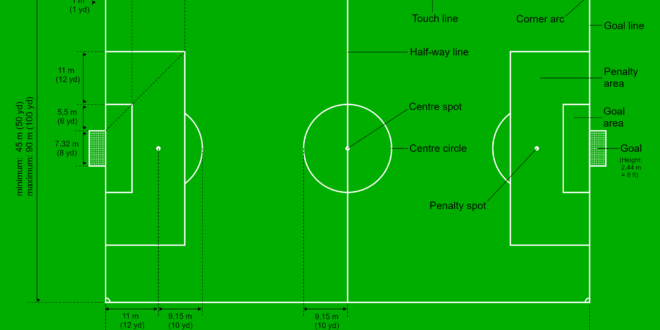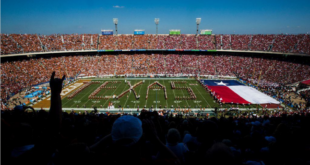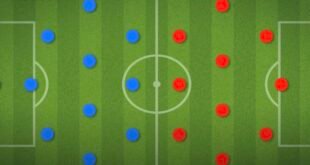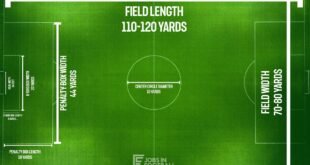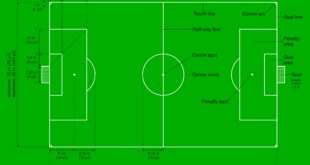The dimensions of a soccer field are 100–130 yards in length and 50–100 yards in width. FIFA regulations suggest an optimal size of 110–120 yards long by 70–80 yards wide for international matches.
Soccer, or football as it is known outside of North America, is a sport that brings people together from all corners of the world. The size of the pitch is vital for the game’s flow and tactics. Professional and international matches are played on fields that align with FIFA’s recommended dimensions, ensuring a standard playing experience at the highest levels.
These dimensions impact players’ endurance, team strategies, and the overall pace of the game. People watching or participating in soccer should understand the importance of field size, as it greatly influences the nature of the match. Without uniform dimensions, comparing the quality of play across different venues would be challenging. Hence, whether you’re watching the World Cup or a local league, the field plays a significant role in the beautiful game.
🔴What are the Dimensions of a Soccer Field🔴

Table of Contents
Introduction To Soccer Field Dimensions
Understanding the size of a soccer field is crucial for players, coaches, and fans. It affects how the game is played and enjoyed. Fields can vary, but they all follow strict guidelines. These ensure the game is fair and consistent worldwide.
A soccer field’s size can impact tactics and the players’ physical demands. Knowing the dimensions helps in appreciating the game’s intricacies.
The Importance Of Standardized Play Areas
Standardized field sizes offer a level playing field. Everyone gets the same conditions to showcase their skills. This consistency is key to fair competition. It ensures that strategy and talent decide outcomes, not varying field sizes.
- Uniform dimensions keep games fair.
- Players and teams can prepare without surprises.
- Fans can better understand and enjoy the game.
Regulatory Bodies Governing Field Dimensions
Several organizations set rules for soccer field sizes. The main body is FIFA. Its regulations are followed worldwide. Other bodies, like UEFA and CONMEBOL, adopt FIFA standards too. They ensure that fields meet specific length and width requirements.
| Organization | Role in Regulation |
|---|---|
| FIFA | Global soccer field standards. |
| UEFA | European competitions adhere to FIFA’s rules. |
| CONMEBOL | South American fields meet FIFA’s requirements. |
Soccer fields must fit within a set range:
- Length: 100m to 110m (110 to 120 yards)
- Width: 64m to 75m (70 to 80 yards)
This range allows for some flexibility based on the venue’s capabilities.
Soccer Pitch Size Specifications
Welcome to the essential guide on the ‘Soccer Pitch Size Specifications’. Grasping the various dimensions of a soccer field is crucial. It’s a key aspect that affects gameplay. Let’s dive into the specifics, looking at the size range and differences between international and domestic pitches.
Length And Width Ranges
A soccer pitch comes in different sizes. There is a range that’s important to know. Fields can vary notably in size but must fit within the recommended dimensions. According to FIFA, the length of a soccer field should fall between 100 and 110 meters and the width between 64 and 75 meters. This ensures the field is both fair and challenging.
| Dimension | Minimum Size (meters) | Maximum Size (meters) |
|---|---|---|
| Length | 100 | 110 |
| Width | 64 | 75 |
International vs. Domestic Pitch Dimensions
When comparing international and domestic pitches, differences emerge. International matches require a strict adherence to size regulations. All dimensions must align with the FIFA standard. For domestic matches, fields can slightly vary within the accepted range. This flexibility acknowledges the constraints of various venues. However, professional leagues often mirror international standards.
- International Matches: Follows FIFA’s strict size regulations.
- Domestic Matches: More flexible, yet typically close to the FIFA standard.
Understanding the specific dimensions of a soccer field is essential. The proper sizes create an equal playing field for all competitors. Now that you have a grasp of the sizes, enjoy the game knowing how the field dimensions play into the dynamics of soccer.
Markings On The Soccer Pitch
Understanding the markings on a soccer pitch is key to playing the game right. Lines, boxes, circles, and spots define how players interact on the field. Let’s explore the meaning behind these pitch patterns.
The Significance Of Field Markings
Every stripe on the turf holds importance. The field’s boundaries are obvious, marked by lines called touchlines and goal lines. The halfway line splits the pitch, while the center circle and spot dictate kick-offs. These elements guide gameplay, providing structure and rules.
Detailing The Penalty And Goal Areas
The penalty area, also known as the 18-yard box, is crucial for determining fouls and goalkeeping rights. The smaller goal area, or 6-yard box, outlines where goal kicks restart play. Here’s a detailed description of these areas:
- Penalty Area: A large box extending 18 yards from the goal line, defining the keeper’s domain and the spot for penalty kicks.
- Goal Area: A smaller box (6 yards from the goal line) where goal kicks take place, and attackers face restrictions.
To give precise field measurements, let’s look at these through a table:
| Area | Dimensions |
|---|---|
| Penalty Area | 44 x 18 yards |
| Goal Area | 20 x 6 yards |
| Penalty Spot | 12 yards from goal |
Corner arcs and penalty arcs are two other vital pitch markings. The former marks where corner kicks are taken from. The latter outlines the no-go zone for players during a penalty kick, except for the shooter and the opposing goalkeeper.
Corner Arcs And Goal Posts
Understanding the corner arcs and goalposts is crucial for soccer enthusiasts, players, and coaches alike. These essential components define critical areas of the game where corner kicks take place and where the scoreline can change with a single shot. Let’s delve into the specifics of these key features of a soccer field.
Radius Of Corner Arcs
Each corner of a soccer field features an arc. This is where players take corner kicks from. The radius of these arcs is 1 yard (0.914 meters). When a corner kick occurs, opposing players must remain outside this arc until the ball is in play. These small, yet significant, semi-circles play a big role during set-pieces in the game.
Dimensions And Positioning Of Goal Posts
The excitement of the game often happens here—at the goalposts. A standard soccer goal measures 8 feet high (2.44 meters) and 24 feet wide (7.32 meters). The position of these goalposts is at the center of the goal line. They are the deciding factor between a triumphant goal and a near miss. Goal dimensions ensure fairness and uniformity in the game of soccer.
| Feature | Measurement | Location |
|---|---|---|
| Corner Arc Radius | 1 yard (0.914m) | At each corner |
| Goal Post Height | 8 feet (2.44m) | On the goal line |
| Goal Post Width | 24 feet (7.32m) | On the goal line |
The Center Circle And Halfway Line
The dimensions of a soccer field are vital for the flow of the game. Let’s explore the center circle and halfway line, crucial elements that define how the game starts and resumes.
Defining The Center Circle’s Role
The center circle on a soccer field serves a specific purpose. It marks the area where players kick off the game and restart it after a goal. This circle ensures that opposing players maintain a fair distance during these moments, giving the team in possession a chance to start their play.
- Kick-offs: take place within this circle.
- Opposing players: must stay outside the circle during a kick-off.
- Radius: a set distance to keep fair play.
Measuring The Halfway Line
The halfway line bisects the field.
It signifies equal halves for the two competing teams. It’s aligned with the center circle and ensures an equal playing area for both sides.
| Feature | Function |
|---|---|
| Halfway Line | Divide the pitch into two halves |
| Location | The midpoint of the longer touchlines |
The midway point on this line aligns with the exact center of the pitch. It helps position the ball for the start or restart of the game.
- Start/Restart: Places ball for beginning actions
- Orientation: Helps players align during play
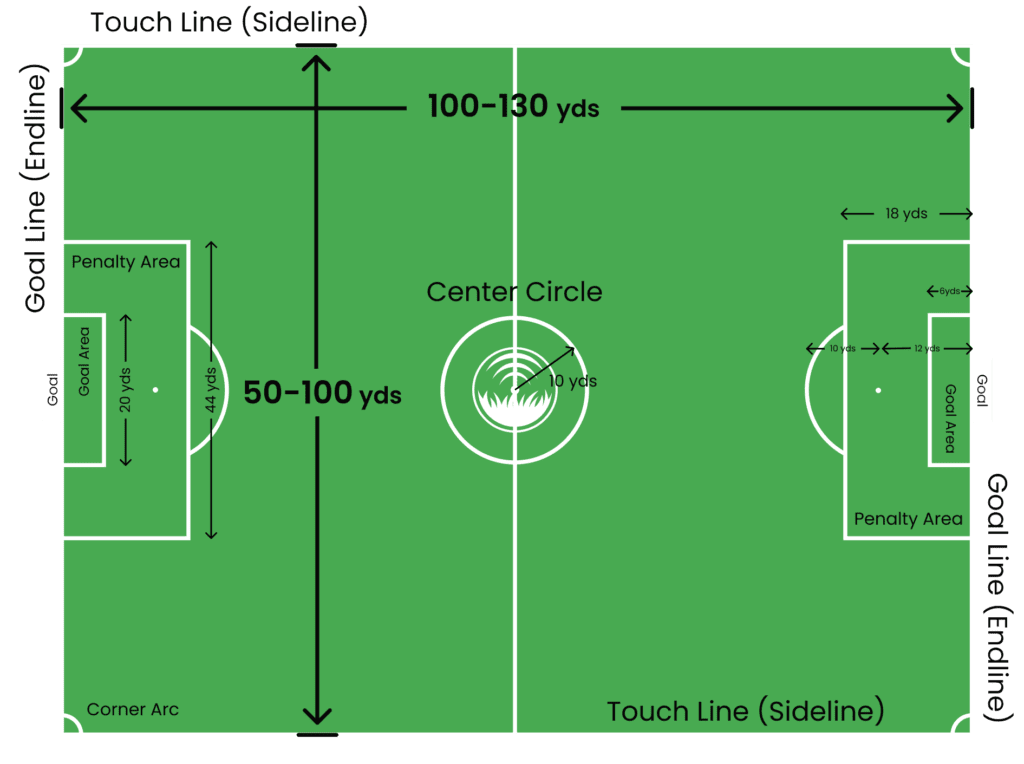
The Penalty Spot And Arc
The significance of the Penalty Spot and Arc in soccer cannot be overstated. Located within the penalty area, these features play a critical role during some of the most pivotal moments of the game. Accurate placement of the penalty spot and the proper arc curvature are essential for fair play.
Precise Positioning Of The Penalty Spot
The penalty spot stands as the focal point for penalty kicks. Its placement must abide by the official soccer regulations. The spot is marked 12 yards (11 meters) from the goal line. This distance must be measured correctly to ensure fairness. The following points highlight the importance of its location:
- The spot determines the kicking point for penalties.
- It must be equidistant from the goalposts.
- Correct positioning affects the difficulty of the penalty kick.
Understanding The Penalty Arc
The penalty arc serves an important purpose during a penalty kick. This semi-circle has a radius of 10 yards (9.15 meters) from the penalty spot. It ensures that all players, except the kicker and the goalkeeper, are at the right distance during the kick.
| Feature | Function | Measurement |
|---|---|---|
| Penalty Spot | Kicking Point | 12 yards from the goal line |
| Penalty Arc | Keep players at a distance | The radius is 10 yards from the spot |
Here are some key takeaways about the penalty arc:
- Players must remain outside the arc until the ball is kicked.
- Its curvature is part of the penalty area circle.
- The exact arc radius ensures consistent enforcement of the rules.
Variations Across Different Leagues
When you watch soccer from different parts of the world, you might notice the fields vary in size. This isn’t by chance; there are specific regulations that allow for variations in field size across different leagues. The dimensions set by governing bodies like FIFA, UEFA, or CONCACAF can differ, depending on the level of play and the league’s rules. Understanding these variations is crucial for players, coaches, and fans alike.
Adjusting Dimensions For Youth Soccer
Youth soccer fields are smaller. This makes the game more suitable for younger players. As kids grow, field sizes increase, helping them adapt to the game step by step. Here’s a simple breakdown:
- U-6: 15-20 x 25-35 yards
- U-8: 20-25 x 30-40 yards
- U-10: 40-50 x 70-80 yards
- U-12: 50-55 x 80-100 yards
- Older age groups start transitioning to adult-sized fields.
Comparing Professional League Variances
Professional leagues may also adopt different field sizes. Though they must stay within FIFA’s recommended range, they have some leeway. For example:
| League | Minimum Size (yards) | Maximum Size (yards) |
|---|---|---|
| Premier League | 110 x 70 | 120 x 80 |
| La Liga | 115 x 74 | 120 x 80 |
| MLS | 110 x 70 | 120 x 80 |
These sizes ensure players experience consistency while also catering to the unique styles of each league. Stadium size and playing style can influence these decisions, ensuring the best possible game for players and fans.
Maintaining The Field For Play
The quality of a soccer game relies heavily on the playing surface. The field must be in top-notch condition. Proper maintenance ensures a safe and fair game. Let’s explore how expert groundskeeping and routine checks keep the field ready for action.
Groundskeeping For Optimal Performance
Impeccable groundskeeping is the secret to a field’s high performance. Here are the key tasks:
- Mowing: Keeps grass at the ideal height for play.
- Aeration: allows the soil to absorb more nutrients and water.
- Fertilization: Fuels grass growth for a resilient turf.
- Watering: Preserves a lush, green field and reduces injuries.
- Line Marking: Bright lines guide players, making calls clear.
Regular Dimension Checks And Adjustments
Correct dimensions are crucial for fair play. Regular checks confirm the field meets official sizes. When adjustments are needed, they must be exact. Here’s a breakdown of standard soccer field dimensions:
| Field Part | Dimension |
|---|---|
| Touchline (length) | 100-110 meters |
| Goal line (width) | 64-75 meters |
| Center circle radius | 9.15 meters |
| Penalty area | 16.5 meters box |
Experts use precision tools for measurements. They ensure the play area is square and the lines are straight. This guarantees a fair game every time.
Technological Assistance In Soccer
The game of soccer continuously evolves, embracing the advancements in technology to enhance every aspect. Technological assistance plays a pivotal role today, from determining the precise dimensions of a soccer field to making critical decisions during matches.
Tech For Precise Field Measurements
Ensuring a soccer field meets official size regulations is crucial. Advanced technology steps in to ensure these standards are met with exactness. GPS devices, laser-guided systems, and drones are now common tools. Here’s how they help:
- GPS devices: – Map out field boundaries and check area dimensions with high accuracy.
- Laser systems – Provide pinpoint measurements for goal placement and line marking.
- Drones – Offer aerial views to inspect the field for any irregularities in shape or size.
Role Of Technology During Matches
During matches, technology ensures fairness and precision in real time. Referees and officials rely on tech for key decisions. Here’s a glimpse into this symbiotic relationship between soccer and technology:
- Video Assistant Referee (VAR) reviews and provides insights on debated plays.
- Goal-line technology – Confirms whether the ball crosses the goal line, avoiding human error.
- Electronic Performance and Tracking Systems (EPTS) – Analyzes player performance with wearable devices.
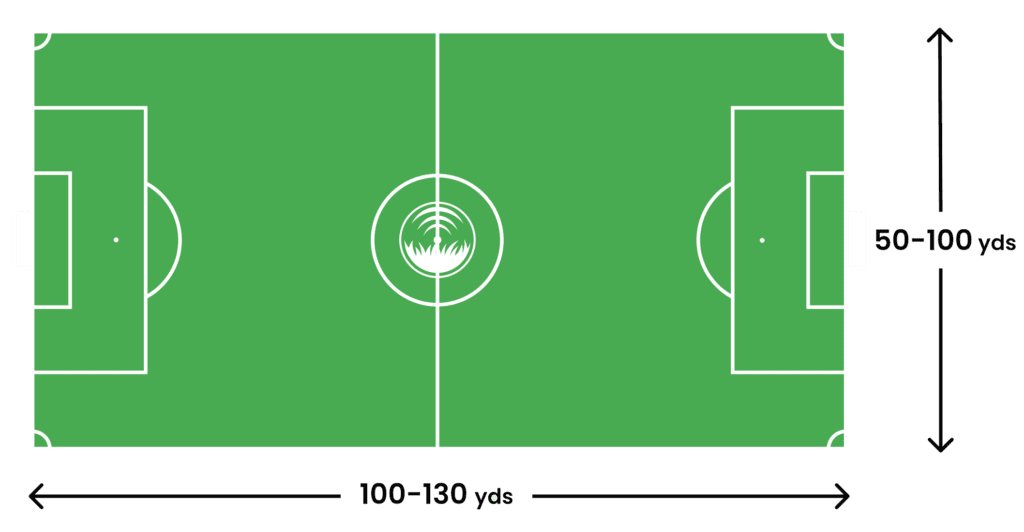
Frequently Asked Questions For What Are The Dimensions Of A Soccer Field
What is the standard size of a soccer field?
The standard length for a soccer field is between 100 and 130 yards, while the width ranges from 50 to 100 yards. International matches often take place on fields measuring 110–120 yards long and 70–80 yards wide.
Does field size vary For Different Leagues?
Yes, the dimensions can vary by league. Youth leagues, amateur clubs, and professional leagues may use different-sized fields within the regulatory ranges to suit different levels of play.
What are the goal area dimensions?
The goal area, also known as the six-yard box, measures 6 yards from the goalposts on either side and extends 6 yards into the field. It is a smaller box inside the penalty area.
How wide is the penalty area on a soccer field?
The penalty area, commonly called the 18-yard box, is 44 yards wide and extends 18 yards into the field from the goal line. It is where penalty kicks are taken.
Conclusion
Understanding soccer field dimensions is crucial for players, coaches, and fans alike. We’ve covered the standard ranges, ensuring a deeper appreciation of the game’s spatial dynamics. Whether for professional matches or local league games, these measurements set the stage for exciting play.
Remember, each pitch holds unique characteristics that echo the spirit of soccer. Keep these figures in mind the next time you’re on or around the field!
 Cric Enjoy Sports News, Cricket Update, Live Streaming
Cric Enjoy Sports News, Cricket Update, Live Streaming
